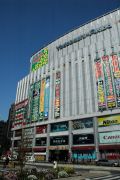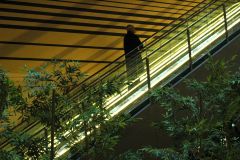Just a week before my arrival, the Tokyo Monorail had eliminated my last minor quibble with it by introducing a non-stop express service and, being headed for Ueno, I decided to give it a spin. I’d forgotten how much fun riding this thing is: swooping up and down, around buildings and warehouses, and now without any stops at Cargo Warehousing Center or Off-Center Catering Complex to spoil the fun. And, like so many other things in Japan, the Monorail just works: trains leave every few minutes and zip past each other in a synchronized symphony of scheduling.
After a crushed commute on the Yamanote, I dumped my bag at Tsukuba Hotel and headed straight off down the Ginza Line to Akihabara to buy a very specific laptop unobtainable outside Japan. (Panasonic “Let’s Note” CF-R6, thank you for asking, and no, you can’t have one.) Akihabara, until recently a low-rent district of cheapo electronics stores inhabited solely by geeks with taped-up glasses, had changed beyond recognition in a few years — high-rises of glass and steel had sprung up all around the new Tsukuba Express station, more were franctically under construction, and half the shops were now devoted to a phenomenon that had pushed its way out of the margins: anime and manga were now everywhere, with big cartoon eyes, giant cartoon cleavage and squeaky cartoon voices competing for your attention in every shop. Girls in maid uniforms were soliciting customers to be served with tea, coffee or a selection of very, very personal services, and now the great unwashed with taped-up glasses and shaggy hair included a great many foreigners out to get their manga fix.
But I found the shop I was looking for, Yodobashi’s new 9-story Akiba monolith, and walked out 15 minutes later (10 minutes of that spent waiting for credit card clearance) with a spanking new laptop. After a murderously strong espresso, I burrowed back to my hotel room and hacked until morning.
The next day, Friday, I was supposed to head out of Tokyo, but around 2 AM a sneaky suspicion crept up on me. I’d booked my flight to arrive at 10 AM in San Francisco, and it was departing at 6 PM, so I’d naturally assumed it was departing on the previous day and that the International Date Line just meant that the flight time of 10 hours actual would be transformed into 18 hours virtual. I’d written it thus on the itinerary I asked my travel agent to book, and he didn’t say a peep, but closer examination of my ticket revealed that I was booked to leave on 6 PM on Saturday — 8 hours after my flight arrived in SFO. Initially I boggled, but when I factored in the International Date Line it all suddenly made sense: actual flight time 8 hours, timezone displacement 8 hours, IDL -24, so relative arrival time would be -8 hours. I now had an extra day in Tokyo!
I extended my hotel stay by a day and set off on a leisurely tour of landmarks old and new. First to Omote-sando Hills, the painfully hip twin development to Roppongi Hills, which had exactly the same kind of pretentiously fancy shops and restaurants, but did finally succeed in making the area partly worth its overused epithet, “the Champs-Elysees of Tokyo”. Harajuku, next door, had grown up from its pre-teen Hello Kitty and sugary crepes phase into an angsty teenager, all Gothic lace push-up bras, black lipstick and dodgy-looking Nigerian dudes hanging out. LaForet, the place to be back when I lived near Shibuya, was looking distinctly scuffed these days. Has it really been ten years!?
Then to Ebisu and the evergreen Tokyo Photography Museum, where I picked the cheapest exhibition (a strategy that has yet to fail me) and goggled at the winners of this year’s Japan Commercial Photography Awards, an intriguing mix of out-and-out advertisements and personal projects by ad photographers. And then onto Roppongi and its just-opened humongous Midtown development, which took a leaf out of Roppongi Hills’ book with huge steel-and-glass towers and one-upped it by adding some much-needed greenery and natural wood paneling to the mix. The sakura in full blossom in the park outside were gorgeous, and I peeked into Fujifilm’s headquarters for their free show of Japan’s 200 best photographers (how they’d picked ’em wasn’t disclosed though). This time much of it was unbearably corny — snowy mountains! cherry blossoms! — but there were a couple of real gems in there. I rued the lack of a decent photography scene in Singapore: the few shows that make an appearance tend to be either arty to the point of incomprehensibility, or hopelessly amateur, a category I already inhabit and hence visit shows to grow out of. Sigh.














